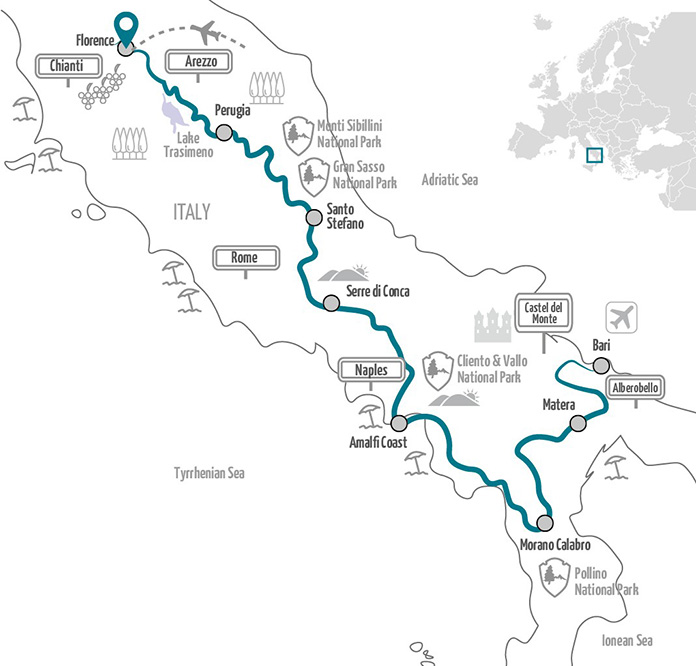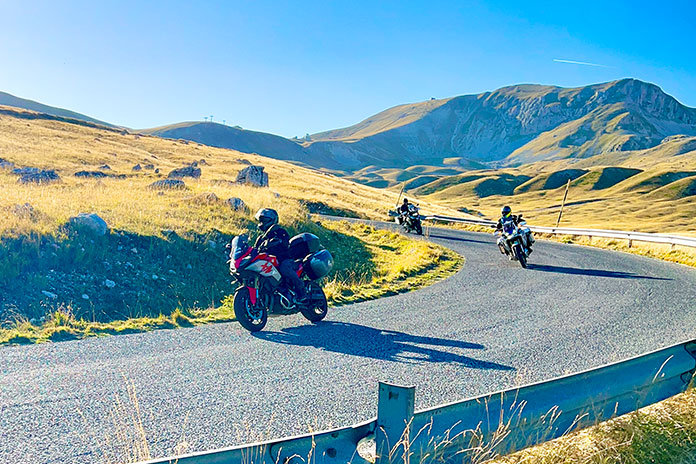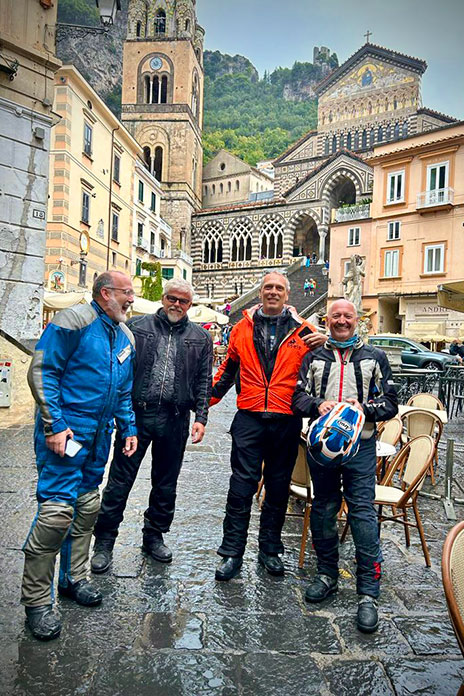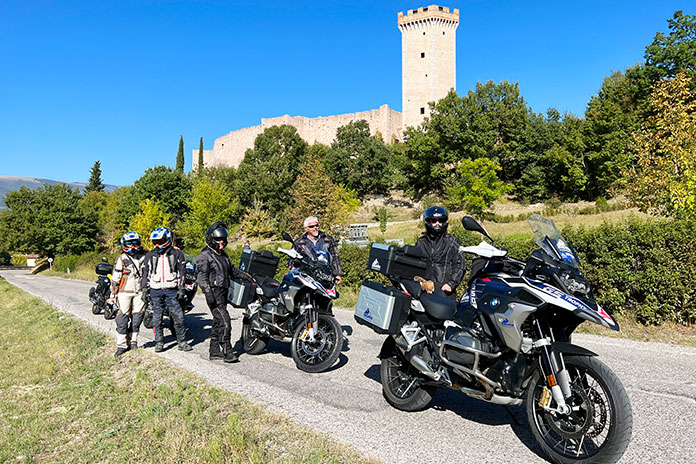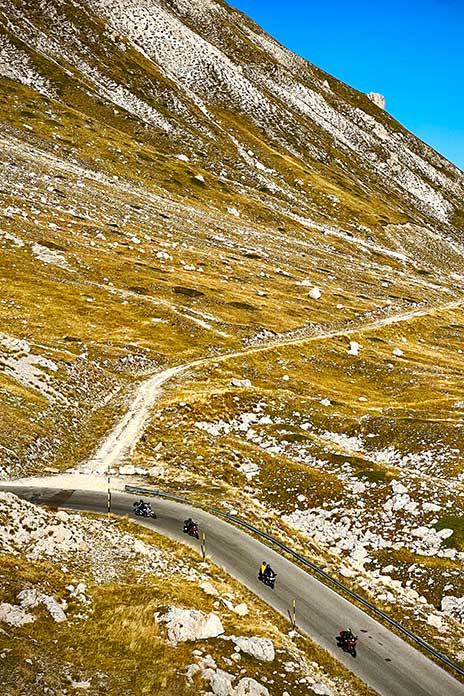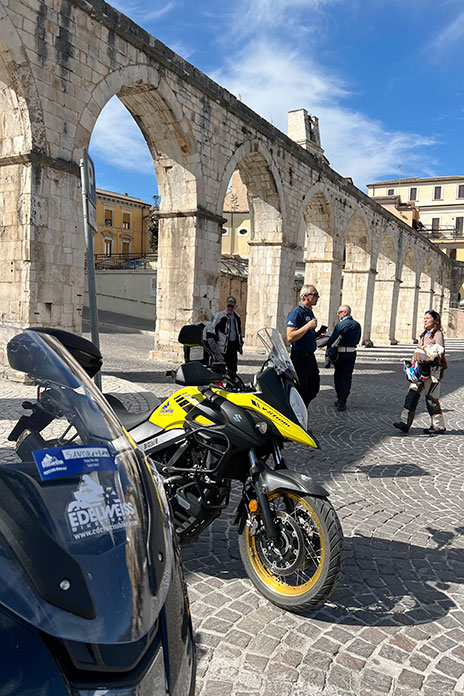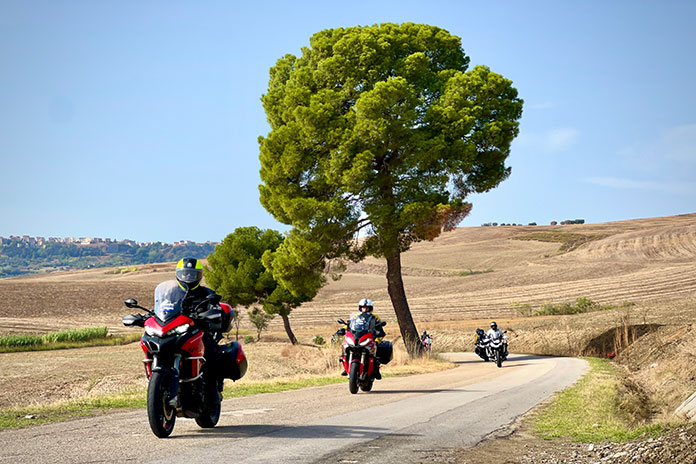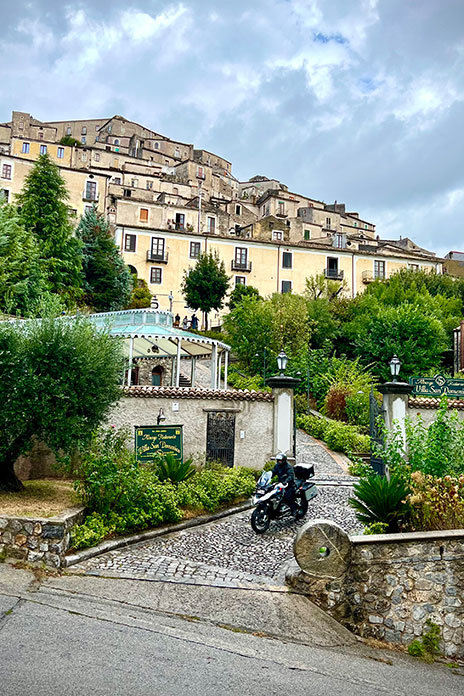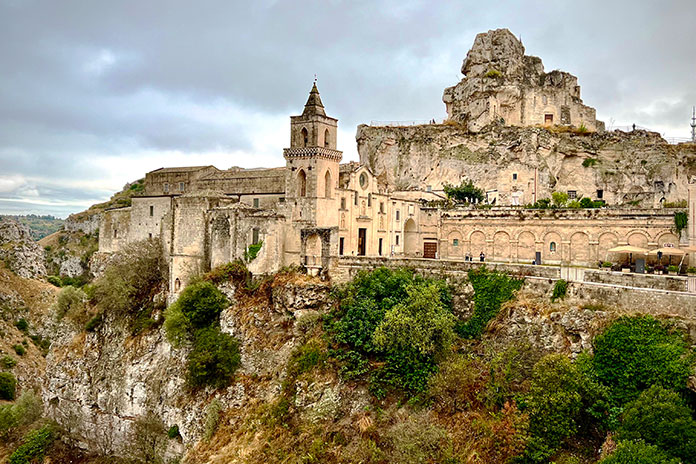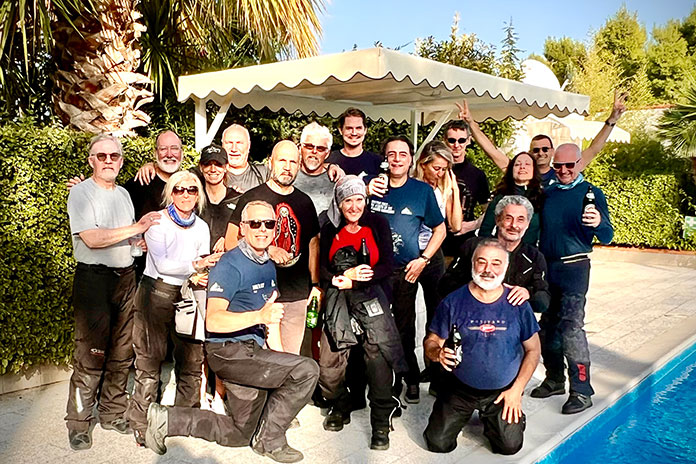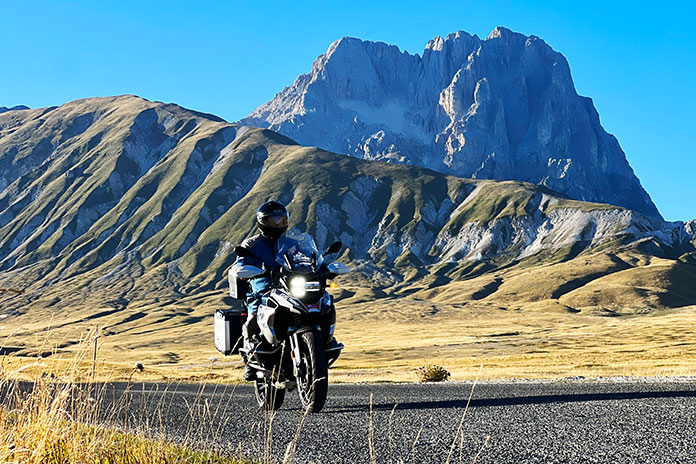
Lying in bed in our darkened hotel room in Morano Calabro, I could hear the loud laughter and music outside. Beneath my open window on the ancient cobblestone walkway of Villa San Domenico, Robin, Shiva, and my wife, Amy, were laughing, singing, and dancing together. Total strangers just a few days earlier, they were now living it up well into the night, despite spending a long day on motorcycles. I had retreated to the room earlier in the evening to jot down my day’s notes and sneak in some much‑needed rest. But instead, I was laying there smiling, soaking in the joy these people had found in each other’s company. I suppose the multiple rounds of Aperol spritz helped a bit too.
We were approaching the final days of the Edelweiss Bike Travel “Unknown Italy: Secrets of the Appenines” tour, a new 10‑day expedition added to the company’s portfolio (starting in 2024, the name of the tour has been changed to “Southern Italy Delights & Twisties”). Starting in Florence in the exquisite Tuscany region, the route traced the Appenines (Appa‑NEENS), the mountainous spine of Italy stretching more than 800 miles down the center of the country. The tour introduced us to the largely unfamiliar mountainous areas situated between the country’s better known eastern and western shores and cities, revealing secrets of the interior regions, which have been there since the beginning of human civilization yet are still largely unknown to tourists.
Related: Edelweiss Bike Travel Releases 2024/25 Tour Brochure
Some of these secrets included wonderfully diverse landscapes that transitioned from rugged stone mountains to soft rolling hills and vast plateaus. We experienced deliciously nuanced foods, each homemade and unique to a region’s own crops, creatures, catches, and culture, and we met delightfully distinct people who welcomed us and were genuinely interested in hearing our stories as well as sharing their own (since these aren’t big tourist areas, the residents were eager to engage, even when language was a barrier).
Although there is a wide socioeconomic range throughout the country, when it comes to beauty, character, history, fascinating people, and utterly amazing food, Italy is rich in every region (we rode through seven out of 20 of them). And while each is impressive on its own, the differences make the entirety even more interesting, more appealing, and infinitely sensational.
Our tour participants were equally diverse and sensational, with folks converging from Turkey, South Africa, Colombia, and all over the U.S. The tour was led by Edelweiss’s energetic and tremendously knowledgeable Domenico, a native Italian and proud son of the city of Naples. He was eager for this fresh opportunity to share the cultural riches and splendid roads of his beloved country, with support from his equally upbeat and capable guides, Michael and Nicolas (aka “Nico”). At one point during a casual group gathering, I stepped back and just listened to the unusual blend of Italian, German, Turkish, Spanish, and a mix of South African and American English dialects as these foreign individuals found common ground and began to seamlessly meld into one harmonious group.
Out on the road, we were all moved by what we saw and awestruck by the continually evolving experience as we rode higher and higher into the remotest parts of the Appenine mountains, away from the bustling cities and out to where cows, horses, sheep, and dogs outnumber residents. With so few restaurant options in these isolated parts, the Edelweiss Bike Travel team even assembled an impromptu open‑air picnic lunch one day amidst the remote hills.
At one point, we saddled up for a spectacular ride into “spaghetti Western” movie country (any Bud Spencer fans out there?) and on through the hills to the Grand Sasso, the jagged “big rock” that marks the highest point of the Appenines.
The diversity continued to unfold as more secrets of the Appenines were revealed, one turn after another. We rode deeper into the wilds of the Abruzzo National Park, tracing the meandering contours of the mountains. The scenery evolved dramatically from craggy rock faces to rolling mountain hills to wide open valleys (think Yellowstone) and then into thick, mature pine forests that are home to deer, bear, fox, and other wildlife. A ride along the shores of several tranquil rivers and lakes was thrown in for good measure.
Eventually, as we turned westward, tall mushroom‑shaped evergreens known as “umbrella pines” indicated we were getting closer to the coast. Sure enough, after countless delicious turns through the hills, the scene opened to reveal the vast Tyrrhenian Sea.
Related: Edelweiss Bike Travel Best of Greece Tour Review
The Alps were millions of years old before the Apennines rose from the sea. But when they did, they did so with gusto, jutting straight out of the water. Along these coastlines, you won’t find long sweeping sand beaches. Instead, the rock face of the mountain shoots nearly straight for the heavens. And a heavenly sight it is. A plaque at the gateway to Amalfi reads something to the effect of: “When you go to heaven, you will have already been there.”
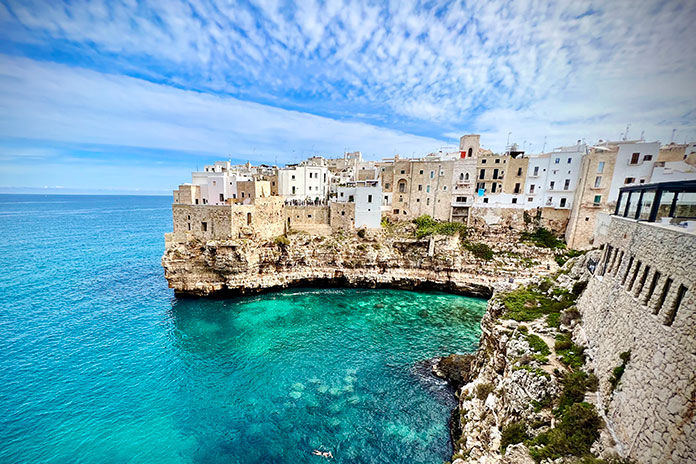
Contrasting with the quiet, empty backroads was the autostrada to Naples and the mad downtown traffic of a city of 3 million people. Cars, bikes, scooters, and buses battled for the same piece of roadway, each insisting on advancing as quickly as possible, while chic passengers of scooterists nonchalantly perused their smartphones amidst all the chaos and seemingly endless near‑misses. In motorcycling’s version of a rude shove into the deep end of the pool, riding in this environment can initially be quite shocking. Eventually, it becomes somewhat normalized and manageable, although certainly out of the ordinary for most American riders. The Turkish contingent on this particular Edelweiss Bike Travel tour thought nothing of it – in fact, it may have even been a bit milder than what they were accustomed to back home.
Just as we became adept at dodging and passing other vehicles in tight spaces, it was back into the open country, where we moved from the Tyrrhenian Sea at the instep of Italy’s boot, tickled the arch at the Ionian Sea, and worked eastward through farm country toward the Adriatic Sea at the boot’s heel.
Our lodging and dining experiences were every bit as diverse, with no two days the same.
We settled into a spectacularly restored 15th century castle, now a first‑class hotel with a beautiful view overlooking its gardens and the city of Perugia. The views would be inspiration even for the Masters’ canvases.
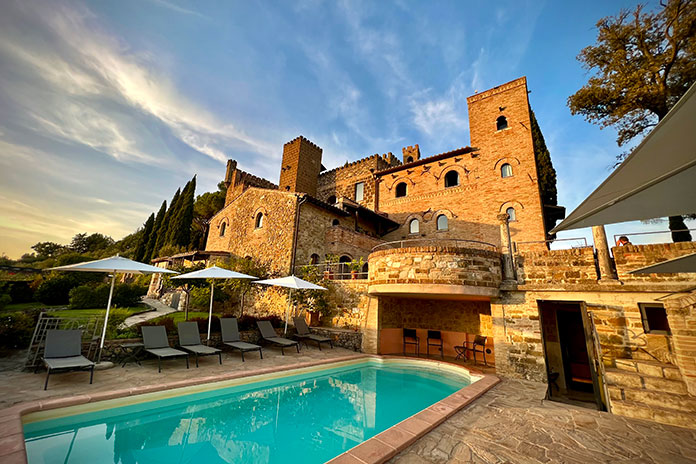
In sharp contrast to the luxurious castle in Perugia, we stayed two nights in the tiny remote medieval village of Santo Stefano di Sessanio. Once an abandoned 15th century hill town left largely in ruins, it has been brought back to life as a distinctive retreat. The village’s buildings and former residences now form the highly unique Sextantio, an “extended hotel.” With the lodging modernized just enough for comfort and convenience, the space preserves much of the original medieval ambiance. It’s an incomparable experience.
We also maneuvered the bikes up narrow, winding mountain roads to a point high above the Amalfi coast, where we stayed in a luxury hotel built on the edge of the rock face, hundreds of feet above the rocky coast. The view from the balcony of our room was spectacular, and a touch terrifying.
Later in our journey, we enjoyed 4‑star modern accommodations and delightful sea‑sourced cuisine in the ancient city of Matera, where the modern civilities and businesses are mixed in among Roman Empire‑era structures dating back to 250 B.C. that were, in turn, built upon the remains of cave dwellings that have been there since the dawn of man’s first colonization (and amazingly, were occupied until the 1950s).
The thing that strikes me most as I consider the secrets of the Appenines and the unknowns of Italy is that it is a land of great contrasts. It’s the contrast of terrain transitioning from rolling hills to rocky cliffs and from farmlands to dense forests and then on to crystal blue seas. It’s the solitude of riding through the untouched rural hill country and then hurtling through frenzied traffic on the autostrada. It’s dodging buses, trucks, cars, and scooters on dense city streets and then dodging goats and working dogs in farmland. It’s the pure, undisturbed silence of a night in the medieval village of Santo Stefano di Sessanio juxtaposed with the roaring high tide of coastal tourists along the Amalfi coast. It’s the paradox of a thoroughly modern 4‑star hotel and restaurant built upon a meager ancient cave city. And it’s also the riddle of 18 people from different parts of the world laughing at the same silly “dad joke,” a brand of humor that transcends international borders, as does the deep, eye‑rolling groan in response.
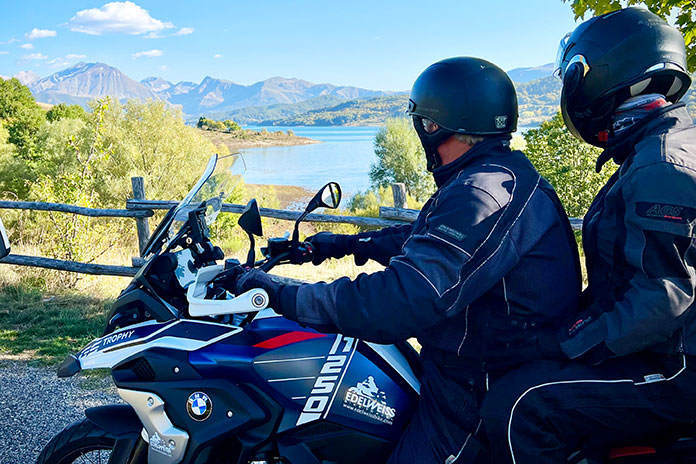
Back in the Villa San Domenico in Morano Calabro, I eventually drifted off to sleep, strangely lulled by the laughter and singing of dear Amy, Robin, and Shiva in the courtyard below my window. Clearly, I slept soundly because I awoke to Amy sleeping peacefully beside me. I smiled as I thought about all the incredible things we’d already seen and experienced, and I marveled at the dynamics of this diverse group of people. With so much global unrest dominating news headlines, it has been almost surreal to find such peace on this ride. Somehow, amidst a troubled and often unfriendly world, this international group immediately restored my long‑held but recently wavering belief that people are, by and large, good and kind. And I was reminded that although we are from disparate lands with strange native languages, we are much more alike than we are different. Perhaps that was the biggest secret revealed in the Appenines.
The Edelweiss Bike Travel Southern Italy Delights & Twisties tour is scheduled to run four times in 2024: May 12‑23, June 3‑14, Sept. 28‑Oct. 10, and Oct. 10‑13. Prices start at $6,360 per person. For more information, visit the Edelweiss Bike Travel website.
See all of Rider‘s international touring stories here.

